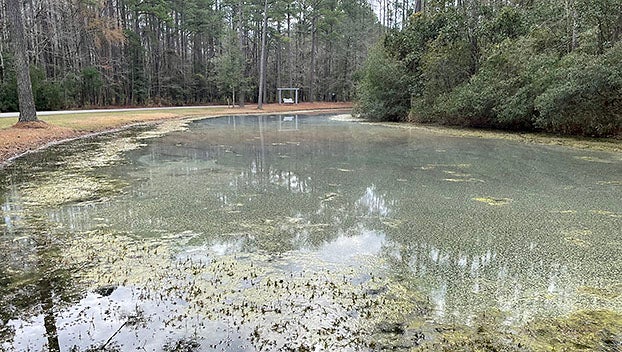Pollen, ozone seasons underway
Published 3:24 pm Friday, March 3, 2023

- Pine pollen is seen floating on the surface of a pond in a Beaufort County neighborhood. (Ashley Vansant / Washington Daily News)
|
Getting your Trinity Audio player ready...
|
Bad news for allergy sufferers. Pollen season is officially underway.
Area agriculture and consumer horticulture agent Gene Fox recognizes the start of the season by calculating daily temperature fluctuations since Feb. 1, but most casual observers know it when they see it — the yellow coating on cars, sidewalks and outdoor furniture.
“All we can really visibly see is the pine pollen,” Fox said. “We’ve got oak trees and we’ve got maple trees and other trees that are in pollen season, too. But their pollen is so small you can’t see it.”
Pollen season in Eastern North Carolina typically begins between mid-February and mid-March. And though the region has experienced an unseasonably warm January and even some record-highs in February, that’s not necessarily an indicator of the intensity or duration of the pollen season, Fox said.
“Folks want to know, when is the last time I’m going to have to wash my patio furniture down,” he said. “We can use these hours to see where we are on the cycle. Unfortunately, it’s the weather that dictates that cycle and no two years are alike.”
Daily pollen levels in Raleigh can be found at the state’s environmental quality website. Most weather stations track local levels as well.
“When it’s hot and dry, there is a lot of pollen released on those days,” Fox said. “It’s almost always worse in the morning than it is in the afternoon.”
Weather patterns over the coming weeks and months will ultimately determine the length of the season.
“If we go back to where we are below those 55-degree temperatures, it kind of stalls everything out,” Fox said. “That prolongs how long we see issues with the pollen. It prolongs how long we see germination of cool-season annuals, while at the same time it’s just warm enough for us to see germination of warm-season annuals. So we have a multitude of issues going on with that.”
OZONE SEASON
March 1 marks the beginning of the 2023 Ozone season as local environmental agencies resume air quality forecasts for ozone in North Carolina, according to a release by the North Carolina Department of Environmental Quality.
“Ground-level ozone forms in the air when nitrogen oxides (NOx) react with hydrocarbons in the presence of heat and sunlight,” according to the DEQ release. “High levels of ozone have been linked to heart and lung conditions, including asthma, particularly in young children, older adults and other sensitive groups.”
Air quality forecasts are available through the state’s Air Quality Portal, a mobile-friendly website launched last year in partnership with the North Carolina State Climate Office. Forecasts are also available through the U.S. Environmental Protection Agency’s AirNow website and app.





